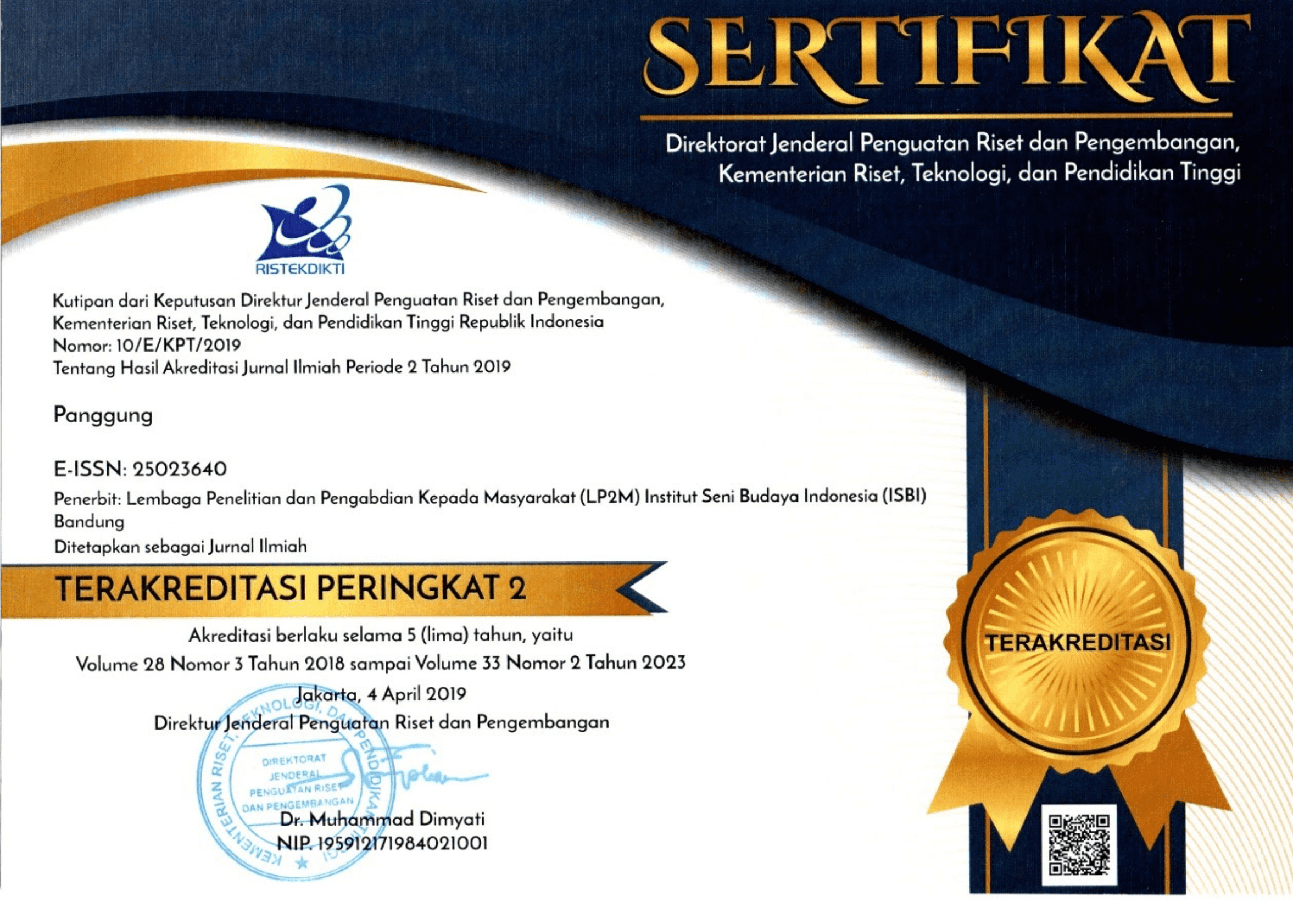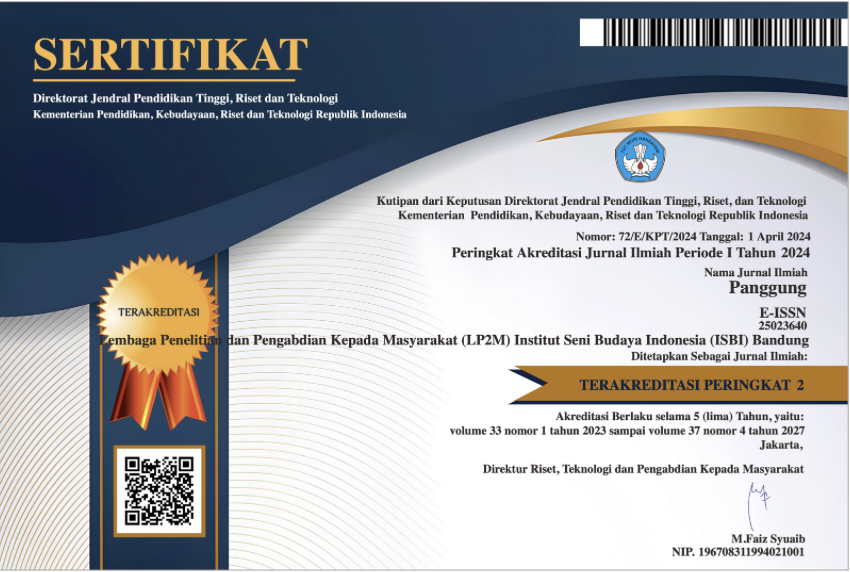Tradisi, Bentuk, Nilai dan Identitas Desain Produk Abad 19-20
DOI:
https://doi.org/10.26742/panggung.v24i2.113Abstract
ABSTRACT
Â
The design has meaning and value. It is not only point out to the object but also refers to the dif- ference meaning contained. The design has a variety of meanings therefore no singular definition will suffice to explain the whole process in design. Design can refer to the knowledge, work and discourse. The process of creating a design in that sense requires consideration of aspects of unity between form, function, meaning and value. Along with the development of science, technology, art and culture, they expanded the meaning of design started by the issues of form into value that ultimately relates to identity. Through literature study of design works from some types of products in a particular period, that every country that has its roots in traditional design were not uniform in defining or classifying designs. A variety of meanings of the design can be determined design position in tradition activities, and actualize it in a different national identity.
Â
Keywords: Education of Art, Design, Tradition, Value and Identity
Â
Â
Â
Â
ABSTRAK
Â
Desain memiliki makna dan nilai, tidak hanya mengacu pada objek tetapi perbedaan mak- na yang dikandungnya. Desain memiliki beragam arti, karenanya definisi tunggal tidak akan cukup menjelaskan seluruh proses dalam desain. Desain dapat mengacu kepada ilmu, karya maupun wacana. Proses membuat desain dalam pengertian tersebut, membutuhkan pertim- bangan aspek kesatuan antara bentuk, fungsi, makna dan nilai. Seiring perkembangan ilmu pengetahuan, teknologi, seni dan budaya, desain mengalami perluasan makna dari persoalan bentuk menjadi persoalan nilai yang pada akhirnya berkaitan dengan identitas. Melalui studi literatur karya-karya desain dari beberapa jenis produk pada masa tertentu, bahwa setiap Ne- gara yang memiliki akar dalam tradisi desain, tidak seragam dalam menentukan atau mem- buat klasifikasi desain. Dari keragaman pemaknaan terhadap desain, dapat ditentukan posisi desain dalam aktivitas tradisi, serta mewujudkannya dalam identitas nasional yang berbeda.
Â
Kata kunci: Pendidikan seni, Desain, Tradisi, Nilai dan IdentitasReferences
Buchanan, R., dan Margolin, V.
Discovering Design, Exploration in De- sign Studies. Chicago: University of Chicago Press.
Dormer, P.
The Meaning of Design . London: Thames and Hudson Ltd.
Erlhoff, Michael
Designed in Germany since 1945. Pre- stel.
Papanek, Victor
Design for The Real World: Human Ecology and social change. New York: Pantheon Books
Pevsner, Nikolaus
The Source of Modern Architecture and
Design. London: Thames & Hudson
Sato, K.
Constructing Knowledge of Design, Understanding Concept in Design Re- search. Chicago, USA: Illinois Insti- tute of Technology.
Walker, J.A.
Design History and the History of De- sign. London: Pluto Press 11-21
Widagdo
Desain dan Kebudayaan, Direktorat Jenderal Pendidikan Tinggi Nasio- nal, Jakarta
Wolfflin, H.
The Principles of Art History: The Problem of The Development of Style in Later Art. (Eng: M.D. Hottinger), Dover Publication, Inc.
Woodham, Jonathan M.
The 20 Century Design. USA: Oxford
University Press.
Downloads
Published
How to Cite
Issue
Section
Citation Check
License
Penulis yang menerbitkan jurnal ini menyetujui persyaratan berikut:
Penulis memiliki hak cipta dan memberikan jurnal hak publikasi pertama dengan karya yang secara simultan dilisensikan di bawah Creative Commons Attribution License yang memungkinkan orang lain untuk berbagi karya dengan pengakuan kepengarangan karya dan publikasi awal dalam jurnal ini.
Penulis dapat mengadakan perjanjian kontrak tambahan yang terpisah untuk distribusi non-eksklusif versi jurnal yang diterbitkan dari karya tersebut (misalnya, mempostingnya ke repositori institusional atau menerbitkannya dalam sebuah buku), dengan pengakuan atas publikasi awalnya dalam jurnal ini.
Penulis diizinkan dan didorong untuk memposting pekerjaan mereka secara online (mis., Dalam repositori institusional atau di situs web mereka) sebelum dan selama proses pengiriman, karena dapat menyebabkan pertukaran yang produktif, serta kutipan yang lebih awal dan lebih besar dari karya yang diterbitkan.
Authors who publish with this journal agree to the following terms:
Authors retain copyright and grant the journal right of first publication with the work simultaneously licensed under a Creative Commons Attribution License that allows others to share the work with an acknowledgement of the work's authorship and initial publication in this journal.
Authors are able to enter into separate, additional contractual arrangements for the non-exclusive distribution of the journal's published version of the work (e.g., post it to an institutional repository or publish it in a book), with an acknowledgement of its initial publication in this journal.
Authors are permitted and encouraged to post their work online (e.g., in institutional repositories or on their website) prior to and during the submission process, as it can lead to productive exchanges, as well as earlier and greater citation of published work.





